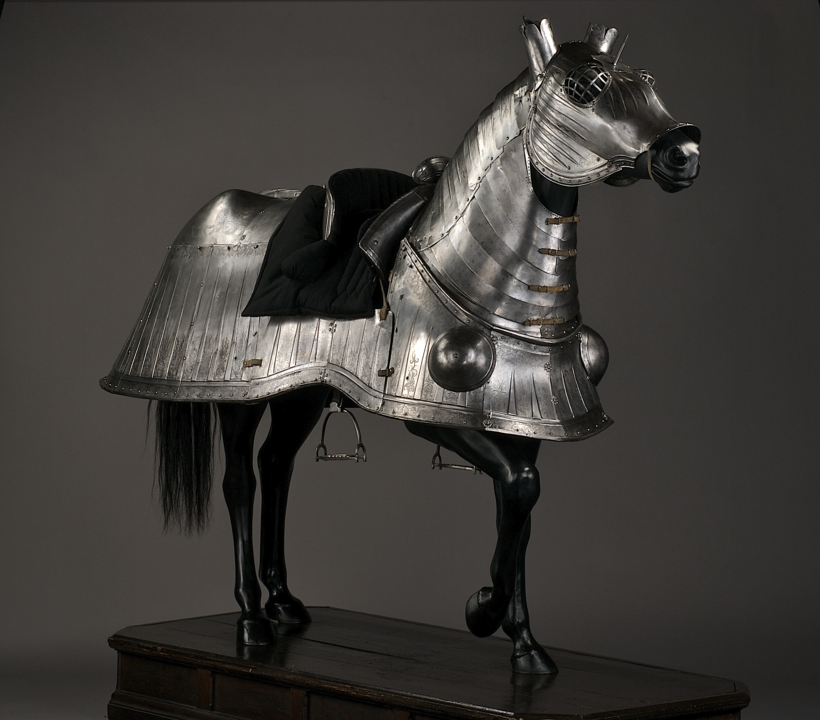Produced in the early 16th century, this suit of horse armour from the workshop of the Innsbruck armourerKonrad Seusenhofer is today one of the show pieces of the collection – especially since, although there are some individual chanfrons, it is the only complete suit of horse armour at the Landeszeughaus.
Discover the
Universalmuseum Joanneum
Graz
Styria
Closed

More than 85 animal species from all continents live in the Herberstein Animal World.
Universalmuseum
Joanneum
Back to Universalmuseum Joanneum
Styrian Armoury > Discover > Collection > Defensive arms > Horse armour
The horse armour includes the chanfron with forehead spike, escutcheon and ear cups, a criniere to protect the neckmade of segmented steel plates, the peytral, with a rounded breastplate at the front and bosses on the side, the flanchards and the adjustable crupper. The plates were made from uncoated steel sheet, on the inside the old padding made of straw sewn into linen is still intact. The saddle and stirrups were added later.
The horse armour or barding was owned by the noble Losenstein family of Upper Austria until January 1614, and was kept in the armoury of Enns. It has unfortunately not yet been possible to determine whether the armour was commissioned by the Losensteiners or whether it came into the family’s possession through purchase or inheritance. Assuming that the armour was made to order for the Losensteiners, it is most likely that its original owner was Wilhelm von Losenstein, who died in 1506. He was imperial councillor to Maximilian I from 1501 on, and was often sent on diplomatic missions. He also represented the emperor as governor of the five Lower Austrian states of Vienna, Austria below the Enns (Lower Austria), Styria, Carinthia and Carniola. As such, he was most certainly in a position to commission prestigious armour such as this.
Wilhelm’s son Sebastian is less likely to have been the purchaser, but could well have been a later owner. He was a guest at the glamorous double wedding in Vienna in 1515 at which the future Emperor Ferdinand I was betrothed to the Hungarian princess Anna. The splendid festivities would certainly have provided an opportunity to show off the armour. It may also have been used at the celebrations held when Ferdinand I and Anna of Hungary were formally married six years later. At that time festivals and tournaments were staged all over the country, on 6 May 1521 in Linz: nobles from many nations met at the “Losensteiner Turnier” held on the main square of the capital of “Österreich ob der Enns” (Austria above the Enns).
Through inheritance, the horse armour was then transferred within the Losensteiner branch of the Losenstein family, from Achatz († 1527), Christoph († 1558), Hans Wilhelm († 1601) to Georg Christoph († 1622), who in January 1614 gave it to his father-in-law, Georg von Stubenberg. The barding remained in the armoury of Enns until that autumn, when it was taken to Oberkapfenberg.
From there, the complete suit of iron armour weighing 42.2 kilograms was transferred to the armoury in 1814 as a donation from the Styrian noble family of Stubenberg. What makes this piece especially appealing is its etched decoration, which can be attributed to the Augsburg painter, illustrator and weapon etcher Daniel Hopfer. The etched escutcheon on the horse’s forehead refers to its past owner, Georg von Stubenberg-Wurmberg. Unfortunately, the letter combination “IEVVDHH” etched on the armour does not provide any concrete information about the first owner or purchaser of the horse armour.

Image Credits


















